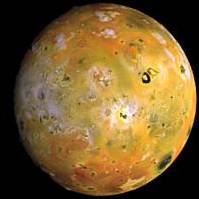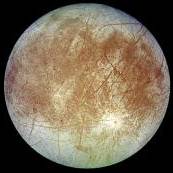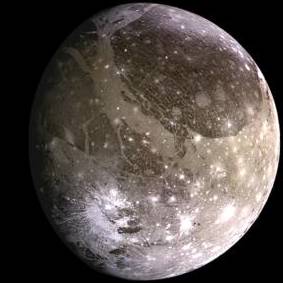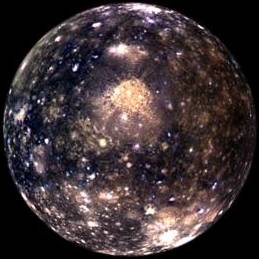Jupiter's satellites
Jupiter has a large family of satellites, numbering 16 in all, as well as being orbited by substantially smaller bodies in its ring, and occasionally by comets (such as Shoemaker-Levy 9). The table below provides some information on the dimensions and orbital characteristics of Jupiter's satellites (Illingworth, 1994; Greeley, 1994).
| Satellite | Year of Discovery |
Diameter (Km) |
Orbital Radius (Km) |
Eccentricity | Orbital Period (days) |
Inclination (°) |
|---|---|---|---|---|---|---|
| Metis | 1979 | 40 | 128 000 | 0.0 | 0.29 | 0.0 |
| Adrastea | 1979 | 25 x 20 x 15 | 129 000 | 0.0 | 0.30 | 0.0 |
| Amalthea | 1892 | 270 x 165 x 150 | 181 000 | 0.003 | 0.50 | 0.40 |
| Thebe | 1979 | 110 x 90 | 222 000 | 0.015 | 0.67 | 0.8 |
| Io | 1610 | 3660 x 3637 x 3631 | 422 000 | 0.004 | 1.77 | 0.04 |
| Europa | 1610 | 3 138 | 671 000 | 0.009 | 3.55 | 0.47 |
| Ganymede | 1610 | 5 262 | 1 070 000 | 0.002 | 7.15 | 0.21 |
| Callisto | 1610 | 4 800 | 1 883 000 | 0.007 | 16.69 | 0.51 |
| Leda | 1974 | 16 | 11 094 000 | 0.148 | 238.72 | 26.07 |
| Himalia | 1904 | 186 | 11 480 000 | 0.158 | 250.57 | 27.63 |
| Lysithea | 1938 | 36 | 11 720 000 | 0.107 | 259.22 | 29.02 |
| Elara | 1905 | 76 | 11 737 000 | 0.207 | 259.65 | 24.77 |
| Ananke | 1951 | 30 | 21 200 000 | 0.169 | 631 R | 147 |
| Carme | 1938 | 40 | 22 600 000 | 0.207 | 696 R | 164 |
| Pasiphae | 1908 | 50 | 23 500 000 | 0.378 | 735 R | 145 |
| Sinope | 1914 | 36 | 23 700 000 | 0.275 | 758 R | 153 |
The Galilean Satellites
The Galilean Satellites are so-called because Galileo Galilei discovered them in 1610 with his primitive refracting telescope. The images below (courtesy of NASA/JPL) indicate each satellite's size relative to the other Galilean satellites pictured, the size order being, from smallest to largest, Europa (3138 Km), Io (~3640 Km), Callisto (4800 Km), Ganymede (5262 Km). They are listed below in order of distance from Jupiter, Io being the closest.
 Io is a volcanic world. It completes
two orbits of Jupiter for every one that Europa completes. Combined with
the immense tidal forces of Jupiter, this squeezes it and causes the interior
to remain at an extremely high temperature. As a result, Io is continuously
losing heat from its interior through volcanic eruptions.
Io is a volcanic world. It completes
two orbits of Jupiter for every one that Europa completes. Combined with
the immense tidal forces of Jupiter, this squeezes it and causes the interior
to remain at an extremely high temperature. As a result, Io is continuously
losing heat from its interior through volcanic eruptions.
The varied colours of Io's surface, from white, through mustard yellow to dark reds and browns, reveal that the body is composed almost entirely of sulphur. This is the conclusion that Voyager mission scientists reached shortly after the encounter. In fact, one of the Voyager spacecraft actually imaged an eruption occurring; the first ever witnessed on a body other than Earth.
 Europa is very different from Io.
It consists of a surface sheet of water ice coursed through with brown ridges
and groves. Following more recent images from encounters by the Galileo
spacecraft, these have been interpreted as ice-sheet plate boundaries, like
the borders of tectonic plates on Earth. It is possible that an ocean of
liquid water resides beneath the ice crust, as a result of tidal forces
from Jupiter preventing it from freezing. In theory, if tidal heating is
strong enough, convection cells set up in this vast reservoir of water could
cause ice-plate movement, resulting in features seen on Europa's surface.
Of course, there are many other explanations for the fracture patterns,
such as large impact events. (Greeley, 1994)
Europa is very different from Io.
It consists of a surface sheet of water ice coursed through with brown ridges
and groves. Following more recent images from encounters by the Galileo
spacecraft, these have been interpreted as ice-sheet plate boundaries, like
the borders of tectonic plates on Earth. It is possible that an ocean of
liquid water resides beneath the ice crust, as a result of tidal forces
from Jupiter preventing it from freezing. In theory, if tidal heating is
strong enough, convection cells set up in this vast reservoir of water could
cause ice-plate movement, resulting in features seen on Europa's surface.
Of course, there are many other explanations for the fracture patterns,
such as large impact events. (Greeley, 1994)
More recently, the Galileo spacecraft has detected the presence of an extremely tenuous oxygen atmosphere around Europa, along with a thin cloud of dust particles caused by impacts of dust- and gravel-sized particles.
 Ganymede is the largest natural
satellite in the Solar System. Indeed, it is bigger than two planets,
Mercury and Pluto, and not a lot smaller than Mars! Ganymede has a thick
'mantle' of ice above a rocky core. A thin rocky crust tops this, and is
covered in impact scars which have broken through it and blown out the whiter
ice from beneath onto the surface. Ganymede is also covered in grooves and
linear fault-like features, which remain to be explained. It also has large,
distinctive surface features such as Galileo Regio, one of several dark
regions.
Ganymede is the largest natural
satellite in the Solar System. Indeed, it is bigger than two planets,
Mercury and Pluto, and not a lot smaller than Mars! Ganymede has a thick
'mantle' of ice above a rocky core. A thin rocky crust tops this, and is
covered in impact scars which have broken through it and blown out the whiter
ice from beneath onto the surface. Ganymede is also covered in grooves and
linear fault-like features, which remain to be explained. It also has large,
distinctive surface features such as Galileo Regio, one of several dark
regions.
Cratering on Ganymede occurs in two distinct forms. The first form covers small impacts, which excavate bowl-like depressions. The second type are formed by larger impact events, which have been termed palimpsests. These are large (50 to 400 Km-wide) craters which have been almost entirely 'wiped' from the face of the satellite, leaving only vague outlines and surface shapes to indicate their presence. As it happens, such features were predicted before these moons were even encountered by the spacecraft. Work by various geologists indicated that the icy mantle would respond viscously, flattening itself out following large events, such would have been the energy released into the body during impact. (Greeley, 1994)
 Callisto is the most heavily
cratered body yet visited in the Solar System. This means that the surface
records a long history - no resurfacing events have occurred on Callisto
since very early in its existence. It is the least dense of the Galilean
satellites. This suggests that it possesses the highest proportion of ice
in these four large bodies, yet Callisto is the darkest of them.
Callisto is the most heavily
cratered body yet visited in the Solar System. This means that the surface
records a long history - no resurfacing events have occurred on Callisto
since very early in its existence. It is the least dense of the Galilean
satellites. This suggests that it possesses the highest proportion of ice
in these four large bodies, yet Callisto is the darkest of them.
Callisto, while possessing an impressive collection of impact scars, also has two vast impact basins, called Asgard and Valhalla. Both are surrounded by concentric rings of cracks and ridges extending for hundreds of kilometres from the centres of the basins. The rings extend for over 2000 Km from the centre of Valhalla, which is the largest of the two. Both basins have bright central regions spanning approximately 400 to 600 Km. (Greeley, 1994)